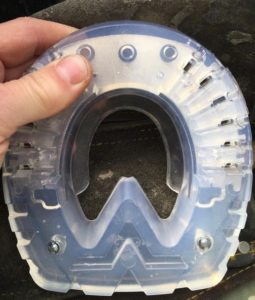Have questions about the EasyShoe Versa Grip?
We compiled some frequently asked questions from customers, and had our resident Certified Farrier Practitioner and Hoof Care Practitioner Dealer Representative, Dan Schroeder, provide his expert answers.
Dan answers questions about the nail holes in the shoes, seeing the white line when applying the shoes, the side clips, the debris guard, and more.
Customer question: Nail holes – the nail holes are shaped so that the nail (E4 slim, as recommended) seems to seat better when it’s turned sideways. My farrier drove the nails the correct/normal way anyway, but it did make him pause for a second. Are the nail holes intentionally narrow to give the nail something to grab as it is driven into the urethane?

Answer: The nail holes are modeled after an E head nail. They are to be driven just like any other shoe. The slot in the nail area is so you have room to move the nail in or out so that you can drive the nail in the white line area of the foot. The slot is designed to make a snug fit against the urethane. If you push it in with your fingers, it will be raised from the ground surface of the shoe. Once it is driven in, it will give it a snug fit to ensure the nail is locked in place.
Customer question: Nail puller channels – my farrier also found that driving the nails the “normal” way means that the slots for the nail pullers are going the wrong direction for the nail head. He was able to pull out a nail that he decided to re-do; I’m not sure what technique he used to do so, but based on his comment, it seems that the nail puller creases weren’t much help. Is there a trick to it?
Answer: The crease that is in place for the nail pullers makes it easier to grab the nail head to pull it out. Yes, it is in the opposite direction of how you would pull a nail compared to a steel shoe, but I can assure you, that it is much more difficult to pull them without the crease in the shoe.
Customer question: White line – my farrier commented that he couldn’t see the white line though the shoes. He did a good job and didn’t quick my horse, so it wasn’t an issue for us, but the description on the website for the Versas seemed to imply the white line would be visible?
Answer: You can see the white line, but it is a bit more difficult with a Versa than a regular steel shoe. Make sure to have really good lighting where you are shoeing, and try marking the white line with a magic marker to make it more visible. The light will make the biggest difference, though.
 Customer question: Clips – the stainless steel clips were harder to bend than traditional steel clips. My farrier resorted to hammering the clips down once the shoe was on – my mare didn’t care for that very much. Is there a better way to do it? Out of curiosity, is there a reason the shoes have a stainless core and clips instead of just regular steel?
Customer question: Clips – the stainless steel clips were harder to bend than traditional steel clips. My farrier resorted to hammering the clips down once the shoe was on – my mare didn’t care for that very much. Is there a better way to do it? Out of curiosity, is there a reason the shoes have a stainless core and clips instead of just regular steel?
Answer: The clips are mild steel not stainless steel. They are a little tougher to bend due to being placed up against the urethane. You can pre bend them on the anvil, or you can hammer them in like you mentioned. One thing that I have done is to grind the base of the clip to make it a little thinner. This will allow you to hammer them in easier, but keep in mind that it will also weaken the clip.
Customer question: Clinching – my farrier didn’t think he was able to get the nail heads to fully seat against the steel core. The bottom jaw of his clincher tool sits flush with the urethane, so the clincher can’t hold the nail any deeper. Is there a special tool he needs to help drive and clinch the nail into the urethane so that it’s seated on the steel?
Answer: Once the nail is seated in the nail slot, it will be just below the urethane ground surface. Using a pair of traditional clinchers will work. You do need to be mindful when you are clinching the nail to “clinch” the shaft of the nail, and not “push” the nail back through the hole. The purpose of clinching the nail is to bend the nail shaft, not to push the nail back through the foot. The nail head will only be slightly deeper than the surface of the shoe. You can also place the jaw of the clincher so that the edge of the jaw is on the nail head. This will allow the edge to be pressed into the slot to put pressure on the nail head.

Customer question: My mare has pretty shallow hooves, so the debris guard is pushed up against her sole. She doesn’t seem bothered by it, but next time should we cut the debris guard down?
Answer: The debris guard is there to help keep rocks and dirt from getting up into the exposed area between the shoe and the sole of the foot. If it is too tall or you are worried about it creating pressure, you can absolutely remove it before you apply the shoe.
Find more frequently asked questions under the FAQ tab on the EasyShoe Versa Grip product page.
Have more questions? Let us know in the comments!





